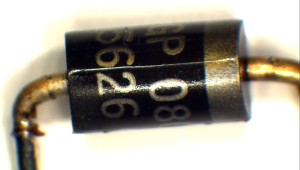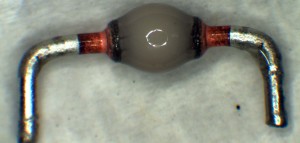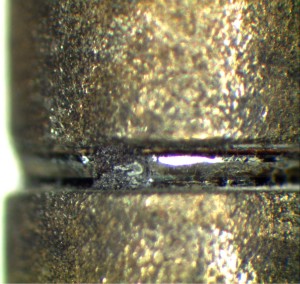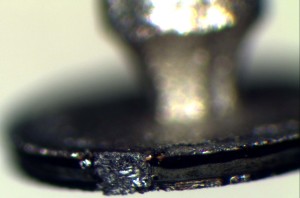Failure Analysis on 1N5626GP Diode
Gideon Analytical Labs received one failed 1N5626GP diode and several good ones for comparison. According to a Wikipedia post, a p–n junction diode is made of a crystal of a semiconductor, usually silicon, but germanium href=“https://en.wikipedia.org/wiki/Gallium_arsenide">gallium arsenide are also used. Impurities are added to it to create a region on one side that contains negative charge carriers (electrons), called an n-type semiconductor, and a region on the other side that contains positive charge carriers (holes), called a p-type semiconductor. When the n-type and p-type materials are attached together, a momentary flow of electrons occurs from the n to the p side resulting in a third region between the two where no charge carriers are present. This region is called the depletion region because there are no charge carriers (neither electrons nor holes) in it. The diode’s terminals are attached to the n-type and p-type regions. The boundary between these two regions called a p–n junction is where the action of the diode takes place. When a sufficiently higher electrical potential is applied to the P side (the anode) than to the N side (the cathode), it allows electrons to flow through the depletion region from the N-type side to the P-type side. The junction does not allow the flow of electrons in the opposite direction when the potential is applied in reverse, creating, in a sense, an electrical check valve.
There is a slight nick in the glass diode to the right of the failure site. The remainder of the glass is unaffected and appears as a new device. Sometimes it is difficult to say which happened first whether the glass chip caused the fusion of the glass and shorting or whether excessive current caused the short and cracked the glass. In this case, the glass sliver was not found. This leads us to conclude it was manufacturing anomaly. This diode should have shorted almost instantly (very short life) in the application. If another diode is replaced in this failure site and it works, then the failure is also suggesting a manufacturing anomaly. The conclusion was that a manufacturing anomaly caused a fracture in the glass producing leakage current, which in turn, caused a catastrophic failure in the glass diode.
The life expectancy would be very short on such anomalies as this. When the die was replaced, the new one ran flawlessly. Gideon Analytical Labs can save money, production and manufacturing time by addressing the problem as soon as possible. Call us with your component failure.

Encapsulated Diode

Decapsulated Diode

Diode with tin slugs

Diode Failure Site